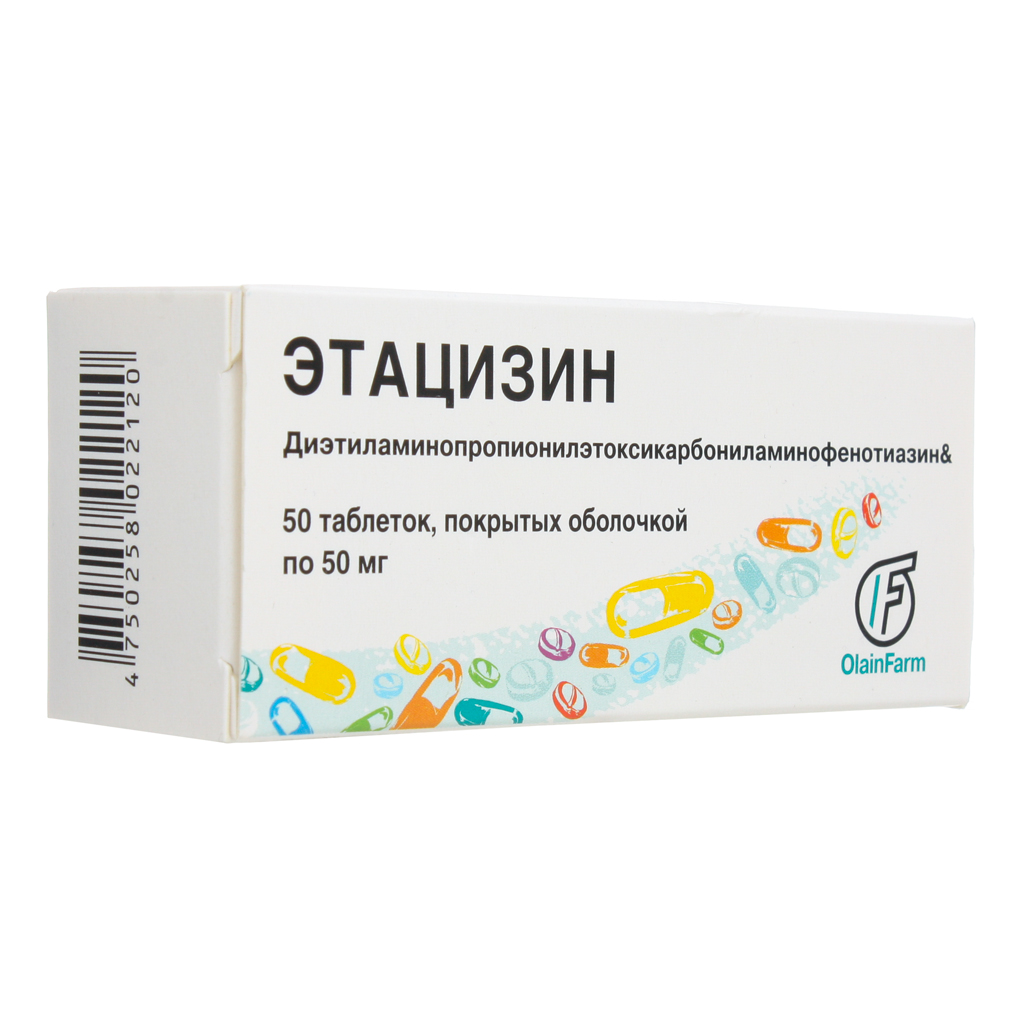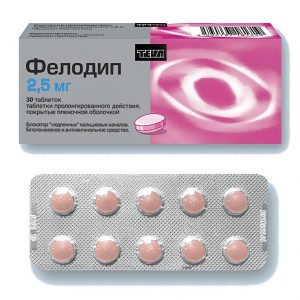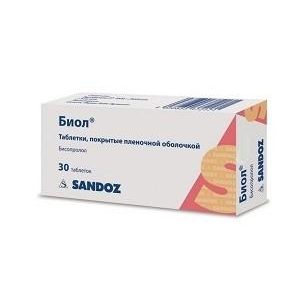Description
Release form
Coated tablets.
Packing
50 pcs.
Pharmacological action
Etatsizin is an antiarrhythmic agent of the IC class, has a long antiarrhythmic effect. It inhibits the rate of rise of the front of the action potential (Vmax), does not change the resting potential. Depending on the dose, it may reduce the duration of the action potential. Does not change significantly effective refractory periods of the ventricles and atria. It inhibits fast incoming sodium current and, to a lesser extent, slow incoming calcium current.
Etatsizin slows down the excitation of the myocardial conduction system. On the ECG, an extension of the PR interval and the QRS complex appears, the ST interval, which reflects ventricular repolarization, does not change or tends to shorten.
Etatsizin raises the threshold for myocardial fibrillation. Unlike many antiarrhythmic drugs, etatsizin does not cause a significant decrease in heart rate or lengthening the duration of the QT interval on the ECG.
The antiarrhythmic effect when taken orally develops usually on the 1-2nd day, the duration of the course of treatment depends on the form of arrhythmia, the effectiveness and tolerability of the drug.
Pharmacokinetics
When taken orally, it is rapidly absorbed from the digestive tract and determined in the blood after 30-60 minutes. Cmax in plasma is reached after 2.5 3 hours. Bioavailability is 40%. 90% binds to plasma proteins. T1 / 2 is 2.5 hours. The pharmacokinetics of etatsizin are subject to significant individual fluctuations and require individual study in individual patients to determine the optimal concentration of the drug in blood plasma. Intensively metabolized during the “first passage” through the liver. Some of the resulting metabolites have antiarrhythmic activity. Etatsizin is excreted from the body by the kidneys in the form of metabolites. Etatsizin crosses the placental barrier. Excreted in breast milk.
Contraindications
increased individual sensitivity to etatsizin or
excipients marked conduction disturbances (including sinoatrial blockade, AV block II and III degree in the absence of an artificial pacemaker), impaired intraventricular conduction
severe left ventricular myocardial hypertrophy
presence of post-infarction cardiosclerosis
cardiogenic shock
severe arterial hypotension
chronic heart failure II and III functional class (FC)
sr up to 18 years) – effectiveness and safety are not established
simultaneous administration of MAO inhibitors
simultaneous use with antiarrhythmic environments tvam IC (moratsizin, propafenone, VFS) and IA (quinidine, procainamide, disopyramide, aymalin) class
any form of cardiac arrhythmias in combination with conduction block of His-Purkinje system.
With extreme caution: with sick sinus syndrome, bradycardia, degree I AV block, coronary heart disease, severe peripheral circulatory disorders, chronic heart failure I FC, angle-closure glaucoma, BPH, cardiomegaly (increased risk of arrhythmogenic effects), electrolyte imbalance (hypokalemia, hyperkalemia, hypomagnesemia), liver.
Special instructions
Like other antiarrhythmic drugs, etatsizin can act arrhythmogenously. Therefore, when prescribing Etatsizin, one should: strictly take into account contraindications to the use of the
drug in advance to identify and eliminate hypokalemia
to avoid using in combination with antiarrhythmic drugs IA and IC
classes, it is preferable to start course treatment in a hospital (especially in the first 3-5 days of taking the drug, taking into account the dynamics of the ECG after the initial and repeated doses of Etatsizin or ECG monitoring data)
immediately discontinue treatment with an increase in ectopic ventricular complexes, the appearance of blockade or bradycardia. Treatment with Etatsizin should also be stopped immediately when the ventricular complexes expand by more than 25%, their amplitude decreases, the duration of the P wave on the ECG is more than 0.12 s.
Risk factors for the arrhythmogenic effect of Etatsizin are: organic heart damage (especially myocardial infarction), a decrease in the ejection fraction of the left ventricle, and the maximum dose of the drug. In addition, caution should be exercised in patients with liver disease. In the treatment of Etatsizinom should not drink alcohol.
During therapy, it is necessary to regularly monitor the patient’s condition and the function of CVS (ECG, blood pressure, echocardiography).
Influence on the ability to drive a car or perform work that requires an increased speed of physical and mental reactions. Due to the risk of dizziness during treatment, it is not recommended to drive vehicles or maintain complex mechanisms that require increased attention and concentration.
1 srdlp composition film-coated tablet contains: active substances o: ethacisin (diethylaminopropionylethoxycarbonylaminophenothiazine hydrochloride) 50 mg,
excipients: potato starch – 9.57 mg sucrose – 19.3 mg methylcellulose – 0.33 mg calcium stearate – 0.8 mg,
shell: sucrose – 37, 695 mg povidone – 0.753 mg dye quinoline yellow (E104) – 0.025 mg dye “sunset” yellow (E110) – 0.003 mg calcium carbonate – 6.308 mg basic magnesium hydroxycarbonate – 3.688 mg titanium dioxide (E171) – 0.665 mg silicon dioxide – 0.827 mg carnauba wax – 0.046 mg.
Dosage and Administration
Inside, regardless of food intake. The initial dose is 50 mg (1 tablet) 2-3 times a day. With insufficient clinical effect, the dose is increased (under mandatory ECG control) to 50 mg 4 times a day (200 mg) or 100 mg 3 times a day (300 mg).
Upon reaching a persistent antiarrhythmic effect, maintenance therapy is carried out in individually selected minimally effective doses.
Side effects
From the CCC side: the stop of the sinus node, AV block, violation of intraventricular conduction, decreased myocardial contractility, decreased coronary blood flow, arrhythmia (arrhythmogenic effect is most likely after myocardial infarction and other types of cardiac pathology, leading to a decrease in contractility of the heart muscle and the development of heart failure).
ECG changes: PQ interval lengthening, P wave and QRS complex enlargement.
From the side of the central nervous system: dizziness, headache, staggering when walking or turning the head, slight drowsiness in some cases – diplopia, paresis of accommodation.
From the gastrointestinal tract: nausea.
Possible reduction of side effects or their disappearance after application of the drug for 3-4 days. With prolonged treatment with Etatsizin, they do not increase, and with the cessation of the drug, they quickly disappear.
Side effects depend on the size of the dose and, to avoid them, maximum doses of the drug should not be prescribed.
Drug interaction
Use with other antiarrhythmic drugs IC (morazizin, allapinin, propafenone) and IA (quinidine, procainamide, disopyramide, aymaline) class is contraindicated.
Ethacisine should not be given concurrently with MAO inhibitors.
The combination of beta-blockers with etatsizinom can enhance the antiarrhythmic effect, especially in relation to arrhythmias, provoked by physical exertion or stress.
Overdose of
Etatsizin has a small therapeutic breadth, therefore severe intoxication can easily occur (especially with the simultaneous use of other antiarrhythmic drugs).
Symptoms: prolongation of PR intervals and expansion of the QRS complex, increase in the amplitude of T waves, bradycardia, sinoatrial and AV block, asystole, paroxysms of polymorphic and monomorphic ventricular tachycardia, decreased myocardial contractility, persistent decrease in blood pressure, dizziness, blurred vision, headache, gastrointestinal disturbances.
Treatment: symptomatic for the treatment of ventricular tachycardia should not use antiarrhythmic drugs IA and IC classes of sodium bicarbonate capable of eliminating QRS complex expansion, bradycardia and arterial hypotension.
Storage Conditions
In a dry, dark place at a temperature not exceeding 30 ° C.
The Expiration of
is 3 years.
active substance
Dietilaminopropioniletoksikarbonilaminofenotiazin
conditions granted through pharmacies
In retseptu
PMA pills



